Great Barrier Reef: turtle hacking holidays!
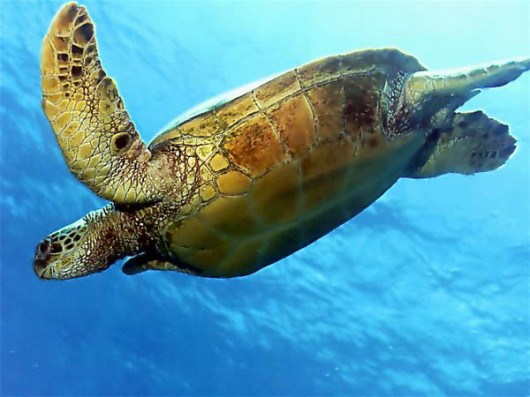 Green Sea Turtle (Chelonia mydas)
Also known as Green Turtle, Black (sea) Turtle, or Pacific Green Turtle and can be found on Australia’s Great Barrier Reef.
The species is listed as ‘Endangered‘ by the IUCN and CITES and is protected from exploitation in most countries where it is illegal to collect, harm or kill them.
Green Sea Turtle (Chelonia mydas)
Also known as Green Turtle, Black (sea) Turtle, or Pacific Green Turtle and can be found on Australia’s Great Barrier Reef.
The species is listed as ‘Endangered‘ by the IUCN and CITES and is protected from exploitation in most countries where it is illegal to collect, harm or kill them.
.
Australia’s Great Barrier Reef is one of the world’s seven natural wonders. It is the world’s largest reef system stretching over 2,600 kilometres from Lady Elliot Island off Gladstone Harbour up to the top of Cape York Peninsula at the Torres Strait.
The Great Barrier Reef has 411 types of hard coral, comprises 900 islands and 2,900 individual coral reefs as well as many cays and lagoons . It is a natural sanctuary for 36 species of marine mammals including whales, dolphins and porpoises, some 1500 fish species, 134 species of sharks and rays, 4,000 types of mollusc and is home to 215 species of birds either migrating, nesting or roosting on the islands.
The Reef and associated beaches provide vital habitat home to six species of sea turtles which swim vast distances to the reef to breed including the Green Sea Turtle. Both the Green Sea Turtle and the unusual Dugong are species particularly threatened with extinction due to Aboriginal Poaching and associated non-traditional commercial exploitation.
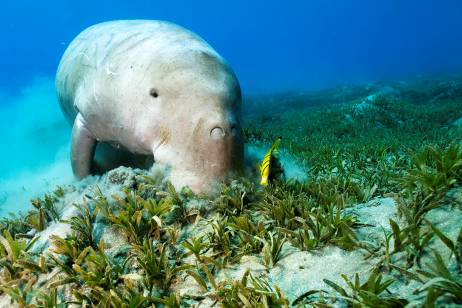 Dugong (Dugong dugon) feeding on Sea Grass Meadows
(Photo by Barry Ingham)
Dugong (Dugong dugon) feeding on Sea Grass Meadows
(Photo by Barry Ingham)
.
Dugongs?
.
Dugongs were hunted toward extinction by European colonists during the 19th Century for their meat and oil.
Most Dugongs now live in the northern waters of Australia between Shark Bay and Moreton Bay particularly in the Torres Strait and along the Grest Barrier Reef. Ongoing ‘traditional’ hunting is driving populations close to extinction. Consequently the IUCN lists Dugongs as ‘Vulnerable‘ to extinction, while the CITES limits or bans the trade of derived products.
Australian Aborigines and Torres Strait Islanders ignore this and continue to poach Dugongs for non-traditional commercial exploitation. ^Read about Dugongs
.
In 1981, The Great Barrier Reef was inscribed on the UNESCO’s World Heritage List under all four natural World Heritage criteria for its outstanding universal value:
- Outstanding example representing a major stage of the Earth’s evolutionary history
- Outstanding example representing significant ongoing geological processes, biological evolution and man’s interaction with his natural environment
- Contains unique, rare and superlative natural phenomena, formations and features and areas of exceptional natural beauty
- Provide habitats where populations of rare and endangered species of plants and animals still survive
.
The IUCN-protected Great Barrier Reef Marine Park is 345,000 square kilometres in size; five times the size of Tasmania or larger that the United Kingdom and Ireland combined!
As scientists have become to understand more about the Reef’s complex ecosystem, they have discovered that damaging fishing practices, pollution and coral bleaching exacerbated by increased sea temperatures due to global warming are compounding to jeopardise the Reef’s future.
The ecological protection and management of the Great Barrier Reef Marine Park is delegated by the IUCN to the safe custody and sovereignty of the Australian Government, currently under the Minister for Sustainability, Environment, Water, Population and Communities, Tony Burke MP. The management task in turn has delegated the responsibility to The Great Barrier Reef Marine Park Authority guided by the Great Barrier Reef Marine Park Act 1975 (Cwlth), which is headquartered in Townsville and with regional offices in Cairns, Mackay, Rockhampton and Canberra.
.
“The Great Barrier Reef is internationally recognised for its outstanding biodiversity. The World Heritage status of the Reef recognises its great diversity of species and habitats. Conserving the Reef’s biodiversity is not just desirable – it is essential. By protecting biodiversity, we are protecting our future and our children’s future.”
.
Great Barrier Reef Tourism
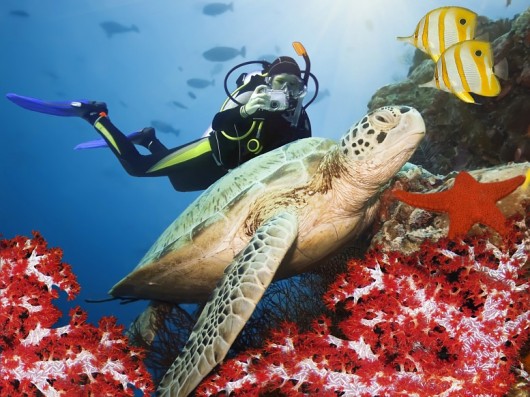 Because of the Reef’s magnificent biodiversity, diving on the Reef is very popular
(Diver with Green Sea Turtle)
Because of the Reef’s magnificent biodiversity, diving on the Reef is very popular
(Diver with Green Sea Turtle)
Tourism Australia promotes the Reef thus:
.
‘Once you’ve experienced the Great Barrier Reef you will know why it is one of the seven wonders of the natural world. Diving and snorkelling are a must. Stay at a one of the many heavenly island resorts. Charter a yacht and sail The Whitsundays. Find your own uninhabited island. Where else in the world can you find a beach where the only footprints in the sand are your own.
There are hundreds of dreamy islands and coral atolls on the World Heritage-listed Great Barrier Reef, so take your pick. Luxury lovers and honeymooners will be in heaven on Lizard Island, exclusive Bedarra or privately-owned Double and Haggerstone Islands. For a wilderness experience, bush camp on Fitzroy Island or trek the Thorsborne Trail along mist-cloaked Hinchinbrook Island. Day trip to Green and Fitzroy Islands, snorkel the brilliant coral reefs of the Low Isles or sea kayak around Snapper Island, Hope Islands National Park with an Aboriginal guide. Townsville, Port Douglas and Lucinda are just some of the mainland gateways.’
.
And at the northern tip of the Reef, Cape York and the Torres Strait Islands are promoted thus:
.
‘Sitting just north of Cape York, between Australia and Papua New Guinea, the Torres Strait Islands are made up of 274 small islands, only 17 of which are inhabited. These communities have developed a unique blend of Melanesian and Australian Aboriginal cultures. Get a glimpse with a trip to Thursday or Horn Island, the group’s most developed islands. Learn about the local pearling and fishing industry on Thursday island, reached by ferry from Cape York. Visit the museum, art gallery and historic World War II sites on Horn Island, accessible by flight. Both islands are blessed with pristine beaches, azure waters and vivid fringing reefs supporting dugongs and sea turtles.’
.
[Source: Tourism Australia, a department of the Australian Government, ^http://www.australia.com/about/australias-landscapes/australias-islands.aspx].
It all seems like idyllic paradise!
.
..
Australia’s disturbing reality on The Reef and at Cape York
There are thousands of native Sea Turtles dying on our Great Barrier Reef as a result of:
- Water Pollution from sewage and stormwater
- Water pollution and farm pestidices, herbicides and fertilisers
- Damaging Fishing Practices
- Illegal Poaching
- Cyclones and Flooding
- Tredging of Gladstone Harbour and associated coastal Industrial Development
- Bulk Cargo Ships leaking contaminants
.
The recent Queensland floods and cyclones have starkly shown the impacts of water pollution on the marine environment. Pesticide and mud pollution from out-dated farming practices has led to a massive spike in Dugong and Sea Turtle deaths.
In addition, poor fishing practices can still kill too many of our Sea Turtles and Dugongs, and industrial development is proliferating along the coast and removing remaining habitats, such as Sea Grass Meadows that Sea Turtles and Dugongs depend on for their survival.
Over the past 12 months, more than 1,400 turtles and 180 dugongs have washed up on our beaches. Clearly our Reef is under enormous pressure and our wildlife is suffering.
The Great Barrier Reef is a World Heritage global icon and something that Queenslanders are proud to be the custodians of. It is unacceptable to many of us that the Reef would be under this amount of pressure. We’re not alone in these concerns – UNESCO’s World Heritage Committee also expressed serious concern recently about the long-term health of the Great Barrier Reef.
[Source: ^http://support.wwf.org.au/queensland-turtles.html].
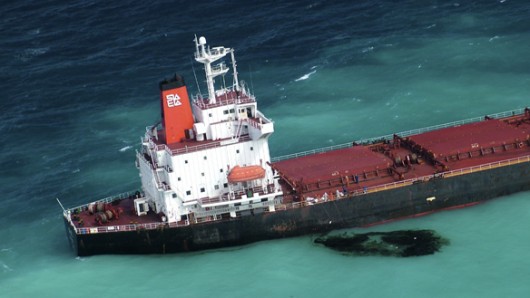 Oil is seen next to the 230-metre bulk coal carrier Shen Neng I about 70 kilometres east of Great Keppel Island, 20100404.
“damage to the reef is significant, with large parts of Douglas Shoal “completely flattened” and marine life “pulverised”.
(Maritime Safety Queensland/Reuters)
Oil is seen next to the 230-metre bulk coal carrier Shen Neng I about 70 kilometres east of Great Keppel Island, 20100404.
“damage to the reef is significant, with large parts of Douglas Shoal “completely flattened” and marine life “pulverised”.
(Maritime Safety Queensland/Reuters)
.
‘130 turtles stranded this year‘
.
‘The Scientific Advisory Committee has been charged with the task of investigating this year’s spate of marine animal deaths in Gladstone Harbour.
Responding to calls for all results to be made public, the environment minister’s office provided the following data:
- 130 turtle strandings were reported; 11 of those were released or in rehabilitation
- Of 119 turtles found dead in the harbour this year, only 24 had autopsies conducted
.
Of those 24 turtles, 13 were identified as dying from human activity (11 boat strikes and two undetermined); 11 were identified as dying from natural causes (10 from ill health and disease and one undetermined).
Eight Dugongs have been found dead. One was killed by boat strike and one from netting. The remaining six were too badly decomposed for autopsies.
Five Dolphin deaths were reported. One was caused by unspecified human activity. The remaining four were too decomposed.
Because floods damaged seagrass levels, marine animals are more vulnerable to human activity.’
[Source: ‘130 turtles stranded this year’, 20110824, ^http://www.gladstoneobserver.com.au/story/2011/08/24/130-turtles-stranded-in-harbour-this-year/].
‘Another Dugong death’
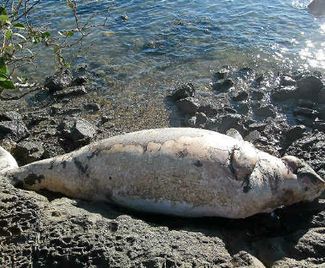 This dead dugong was found on Witt Island by Clive Last (July 2011)
who is increasing worried by marine animal deaths in Gladstone Harbour (Great Barrier Reef).
This dead dugong was found on Witt Island by Clive Last (July 2011)
who is increasing worried by marine animal deaths in Gladstone Harbour (Great Barrier Reef).
.
‘Another dead Dugong has been found in Gladstone Harbour, and the man who found it wants some answers.
Clive Last, who in May discovered a dead dolphin on Turtle Island, was shocked on Friday afternoon when he found the body of a dead Dugong on Witt Island.
Mr Last is wary of suggestions marine animal deaths this year can be attributed to boat strikes and net fishing. He said those explanations didn’t match his observations on the harbour.
“I honestly believe it’s either starvation (from damaged seagrass meadows) or there is something in the harbour,” Mr Last said. “Right now, Turtles and Dugongs are continually coming up. That means there is (something) going on.”
He believed the Dolphin he found in May had no injuries to indicate it had been killed by boat strike or fishing nets.
The Department of Environment and Resource Management reported the Dolphin’s body was too decomposed to conduct a necropsy.
Mr Last said, once again, the dead Dugong’s body showed no sign of injury. He took five photos and called Queensland Parks and Wildlife.
Mr Last, whose work requires him to spend a lot of time on the harbour, is increasingly disturbed by the trend of dead marine animals in Gladstone Harbour.
“If I don’t see another one after today, I’ll be very happy,” he said. “I’d also be very happy if someone would come up with the truth about what is really killing them. “You can’t keep saying it’s boat strike, when I’ve got photos showing it’s not boat strike.”
Mr Last said he was worried the scientific advisory committee’s investigation into the deaths in Gladstone Harbour would take too long to come up with results.
DERM (Queensland Department of Environment and Resource Management) could not be contacted over the weekend.
The list goes on:
- The dead Dugong found on Witt Island was the latest in a long, mysterious list of marine animal deaths this year.
- Three dead Dolphins were found in Gladstone Harbour in May, within two weeks of each other.
- The latest discovery is the fourth Dugong found dead in the harbour since May
- More than 40 Turtles have washed up dead in the harbour since April. The Turtle deaths have been the subject of intense debate between environmentalists and commercial fishermen.
- Marine experts from various organisations have told The Observer seagrass levels, damaged by the floods, are putting stress on the animals.
.
“LNG will deliver billions of Australian Dollars to be shipped overseas as profit we will be left with the rotting carcasses of dead dugongs, poisoned water tables, destroyed farmland and a bill for the infrastructure the council builds for them.”
~ Comment by Chris Norman from Agnes Waters (July 2011)
.
[Source: ‘Another dugong death’ by David Sparkes, The Gladstone Observer, 20110725, ^http://www.gladstoneobserver.com.au/story/2011/07/25/another-dugong-death-marine-deaths-gladstone/]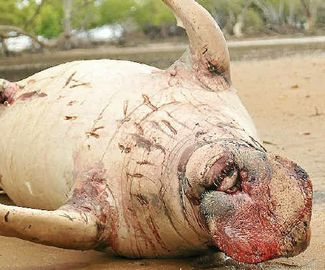 Dugong washed up at Gladstone – marked with gashes
Dugong washed up at Gladstone – marked with gashes
.
Heinous cruelty as Aborigines hack live pregnant Green Sea Turtle
.
There’s tension in far north Queensland between Traditional Hunting rights (Ed: read ‘perversion’) and the protection of Turtles and Dugongs, and it is resulting in some horrific treatment of native animals.
Transcript from ABC Broadcast (extracts of video added):
.
CHRIS UHLMANN, PRESENTER: Protected Dugongs and Sea Turtles are being cruelly slaughtered in Queensland’s Torres Strait to supply an illegal meat trade.
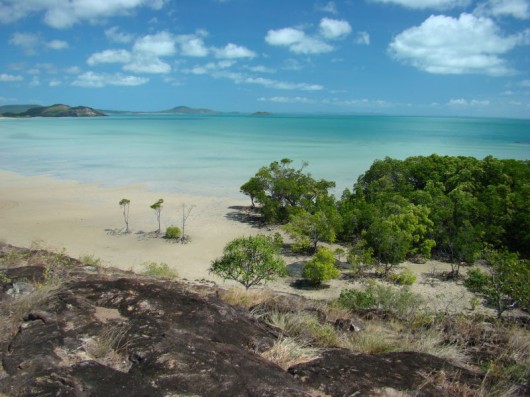 Tranquil coastal tip of Cape York Peninsula and the Torres Strait
Tranquil coastal tip of Cape York Peninsula and the Torres Strait
.
An investigation by 7.30 has found deeply confronting footage that we are about to air. It shows the brutal methods used to hunt the animals, with turtles being butchered alive and dugongs drowned as they’re dragged behind boats.
The investigation throws into sharp relief the conflict between Indigenous Australians and animal rights activists over traditional hunting and exposes a black market in animal meat.
And a warning: this report by Sarah Dingle and producer Lesley Robinson contains disturbing images and coarse language.
SARAH DINGLE, REPORTER: At the northern-most tip of Australia lie the serene islands and waters of Queensland’s Torres Strait, the birthplace of Native Title. But on those beaches, there’s a slaughter underway.
7.30 travelled to far North Queensland where IT entrepreneur turned eco warrior Rupert Imhoff has been investigating the fate of threatened turtle and dugong populations. And what he found is shocking. A turtle lies tethered for up to three days, waiting to die.
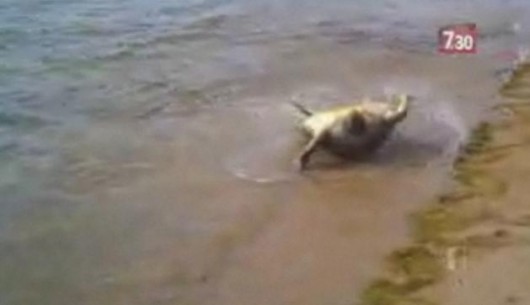 Green Sea Turtles are routinely tethered by rope by local Aboriginal/Torres Strait Islander men in the shallows,
then inverted on to their backs so that they tire from struggling and often drown.
Green Sea Turtles are routinely tethered by rope by local Aboriginal/Torres Strait Islander men in the shallows,
then inverted on to their backs so that they tire from struggling and often drown.
.
RUPERT IMHOFF, ECO WARRIOR: They dragged it out of the water, flipped it on its back. You could see it was already terrorised. It was flapping around madly. And they came up with this concrete block and basically tried to slam it in the head, obviously to stun the animal. Didn’t quite work.
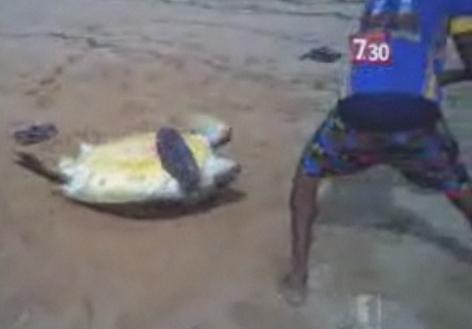 Man uses a concrete block and throws it twice at the Turtles head
but the female Turtle continues to flap. She has no voice.
Man uses a concrete block and throws it twice at the Turtles head
but the female Turtle continues to flap. She has no voice..
SARAH DINGLE: The images become even more confronting.
RUPERT IMHOFF: Before they started hacking off its fins, they wanted to check if it was pregnant, and sure enough this turtle was a mature aged turtle. Had up to 125 eggs in it. It was gonna be the next generation of turtles, but they decided to cut it up right there and then.
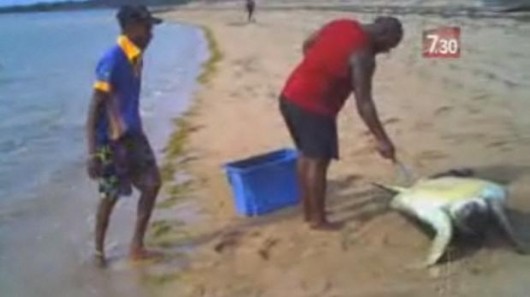 Aboriginal man knifes into the womb of the female Turtle to see it if pregnant
– she is.
Aboriginal man knifes into the womb of the female Turtle to see it if pregnant
– she is.
.
SARAH DINGLE: Even as it’s hacked, the turtle clings to life, apparently in agony for seven and a half minutes.
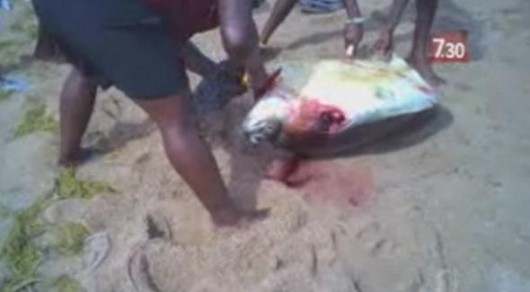 The man then starts hacking into the live healthy Turtle
Left flipper already hacked off, the still live turtle has its right flipper hacked off,
while the men keep it helplessly lying on its back
The man then starts hacking into the live healthy Turtle
Left flipper already hacked off, the still live turtle has its right flipper hacked off,
while the men keep it helplessly lying on its back
.
RUPERT IMHOFF: Didn’t actually die until they took off the bottom shell, they actually peeled off the shell and then it just let out one gasp – one last gasp of air and passed away.
SARAH DINGLE: Using a hidden camera, Rupert Imhoff spent two weeks in the Torres Strait filming the hunting of sea turtle and dugong which are both listed as vulnerable to extinction.
RUPERT IMHOFF: They go out, they spear them at sea, they then tie the tail to the back of the boat and they hold the head underwater. And it can take up to seven and a half minutes again, so I’ve been told, for that dugong to drown.
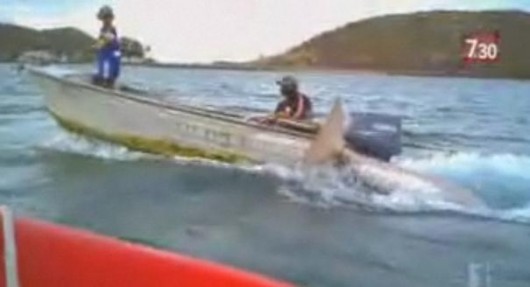 Speared Dugong, still alive is tied by the tail fin to the side of the boat so it drowns as the boat returns to shore
Speared Dugong, still alive is tied by the tail fin to the side of the boat so it drowns as the boat returns to shore
.
SARAH DINGLE: Here, a Dugong is methodically carved up for consumption. For anyone else, this kill would be illegal, as dugong are protected under federal law. However, the Native Title Act allows traditional owners to hunt to satisfy their personal, domestic or non-commercial communal needs.
Anywhere in Australia, this horrific cruelty would be will illegal. But in Queensland alone, Native Title hunting is exempt from animal cruelty laws. Animal rights activists are appalled.
Lawyer Rebecca Smith was a paid consultant on the turtle and dugong hunt for the Torres Strait Regional Authority.
REBECCA SMITH, LAWYER: Most conservation groups won’t touch this issue. It’s just too hard, too prickly, too sensitive. It’s often deemed – people who are opposed to traditional hunting are often called racist, but there’s nothing racist about saying, “This is cruel. We’ll move on from there. We’ll do this humanely now. We’ve progressed.”
SARAH DINGLE: Aerial surveys of dugong and turtle numbers are imperfect and no-one knows exactly how many there are. Green sea turtles face an extra pressure. They’re by far the turtle species most intensively hunted for their meat. But locals say there are bigger threats for turtle and dugong.
???: You know we are under threat from pig predation, our – one of the greatest, biggest rookeries in the Southern Hemisphere on Cape York, Rain Island, is under threat from climate change, but we seem to be concentrating I think far too much on, you know, Indigenous people hunting them.
SARAH DINGLE: What is known is that the Great Barrier Reef is a last stronghold. It’s home to the biggest sea turtle rookery in the globe and one of the world’s largest population of dugong.
Cairns-based Colin Riddell calls himself “The Dugong Man”. A former abattoir worker, he’s an unlikely but tireless campaigner for animal rights.
COLIN RIDDELL, ANIMAL RIGHTS CAMPAIGNER: I have to pursue it to the end because otherwise the end may be for the animals.
SARAH DINGLE: Colin Riddell’s investigations have revealed the slaughter goes on far to the south in coastal Queensland waters.
Green Island is one of the jewels in the crown of Cairns tourism. We’ve been told just last week at this spot Indigenous hunters chased down and took a green sea turtle in full view of shocked tourists. There’s no way of knowing where those hunters came from, but locals say this is a weekly occurrence on this island.
STEVE DAVIES, TOUR OPERATOR: They can be out there a lot, you know – three, four, five times a week. They come across in quite large tinnies with large outboard motors on board and they chase the turtles till they’re completely and utterly exhausted.
SARAH DINGLE: The culture clash between hunters and tourists has led to heated confrontations.
INDIGENOUS HUNTER (Amateur video): This our land! We don’t list end to your shit, mate! We can do anything on this land we wanna do, mate!
SARAH DINGLE: This video was shot two weeks ago by a tourist and given to 7.30. It shows an allocation between a tour boat and three Indigenous hunters.
INDIGENOUS HUNTER (Amateur video): Ya just don’t tell us what to do on our land! You’re not from this f***in’ land; we are! We’re the traditional owner! We own every f***in’ reef around here, mate!
SARAH DINGLE: It’s not clear what they’re hunting for, but there’s no mistaking the tensions.
INDIGENOUS HUNTER (Amateur video): You f*** off back to your country. This is my country, c***.
SARAH DINGLE: Is there a sense in your area that the Indigenous hunters are untouchable?
STEVE DAVIES: Without a doubt. And they believe they’re untouchable.
SARAH DINGLE: But there are conservation efforts.
Well away from the glitzy marinas and the tourist strip, here in the industrial area of Cairns is the town’s only turtle rehabilitation centre. It’s run on the smell of an oily rag. Here, injured and starving turtles are treated and brought back to full health.
Today, Jenny Gilbert and her team are readying a 180 kilogram breeding age female green sea turtle for release. By the look of things, this 80-year-old turtle has already survived a number of hazards.
Turtles like this are being hunted not traditionally, but for a very modern purpose. Our investigations have revealed the hunt is feeding a flourishing black market.
JAMES EPONG, MANDUBARRA LAND & SEA CORP.: Well nine times out 10 the illegal trade is to sell the meat for the benefit – for grog money or drugs.
SARAH DINGLE: And can you can make a buck out of it?
JAMES EPONG: Yes. There’s one person that we know of in Yarrabah made $80,000 one year.
SARAH DINGLE: James Epong is a Mandubarra man who lives on his traditional lands an hour south of Cairns and Yarrabah. The Mandubarra have declared a moratorium on taking turtle and dugong from their see country, but around them, the illegal meat trade continues.
JAMES EPONG: I myself went to a pub on a Friday afternoon to go and have a coldie with one of me mates and was approached by some other Indigenous people with trivac (phonetic spelling) meat for sale, which was turtle and dugong.
SARAH DINGLE: On four separate occasions 7.30 has confirmed multiple eskies arriving on the afternoon flight from Horn Island to Cairns.
RUPERT IMHOFF: I do not know 100 per cent for a fact what was in those eskies, but I have heard numerous reports and been told by the islanders themselves that they are transporting an excessive amount of turtle and dugong down to Cairns. Now on my flight I think there was about six or seven eskies that come off and I’ve been told that it almost a daily routine.
SARAH DINGLE: Indigenous sea rangers are employed and equipped by governments to care for marine wildlife. This esky was addressed to a ranger.
RUPERT IMHOFF: From what I understand and what I observed and what I spoke to the islanders about is the head hunters on all these islands are actually the rangers themselves. Now this money has gone into their pockets. It’s gonna help them buy outboard motors and help them basically go and hunt these turtle and dugong down in bigger numbers.
SARAH DINGLE: Were any of the people you saw hunting and killing animals rangers?
RUPERT IMHOFF: Yes, they were 100 per cent.
SARAH DINGLE: Did you pay those people in your footage to do what they were doing?
RUPERT IMHOFF: We did not pay a single person any money while we were up there.
SARAH DINGLE: And the illegal trade continues further south.
SEITH FOURMILE, CAIRNS TRADITIONAL OWNER: I know that there’s a lot of non-Indigenous people that are doing it as well.
SARAH DINGLE: Are they doing the hunting or are they involved in other way?
SEITH FOURMILE: They’re involved with the trading of it, or selling it and passing it down, and some of the turtle meats has gone far down as Sydney and Melbourne.
SARAH DINGLE: And it’s not just dugong and turtle meat being sold. Traditional owners from Cape York are pushing to end the indiscriminate slaughter and stop the esky trade.
 Sea Turtle air freighted from Cairns to Sydney and Melbourne
Nothing to do with ‘Traditional Hunting’, which is a low-life smokescreen for what it really is:
Illegal Wildlife Poaching and Trade for personal commercial profit.
Sea Turtle air freighted from Cairns to Sydney and Melbourne
Nothing to do with ‘Traditional Hunting’, which is a low-life smokescreen for what it really is:
Illegal Wildlife Poaching and Trade for personal commercial profit.
.
FRANKIE DEEMAL, TURTLE AND DUGONG TASKFORCE: We don’t have that kind of legislative assistance to do that. What do you do when you confront a rogue killer?
SARAH DINGLE: And we’ve heard a lotta people talk about rogue killers. Who are these rogue killers?
FRANKIE DEEMAL: They’re there.
SARAH DINGLE: Who are they?
FRANKIE DEEMAL: They know who they are.
SARAH DINGLE: For those with Native Title rights, customs can change.
LOCAL MAN: We’re gonna name this turtle Bumbida (phonetic spelling), after our grandmother.
SARAH DINGLE: But the Mandubarra people at least have sworn to protect these animals.
CHRIS UHLMANN: Sarah Dingle with that report, produced by Lesley Robinson.
And 7.30 contacted the Queensland Department of Environment and Resource Management. In a statement it said it takes, “the claims very seriously and will investigate all reports of illegal hunting and poaching”.
You can follow the progress of the turtles released in this story by going to the sea turtle satellite tracking page.
Editor’s note: (April 16) the ABC also approached the Torres Strait Regional Authority (TSRA) several times over the course of a week prior to broadcast but their spokesperson was unavailable for comment.
Watch the entire Documentary aired nationally across Australia in March 2012:
WARNING: THIS VIDEO CONTAINS DISTURBING ANIMAL CRUELTY WHICH MAY OFFEND. WE INCLUDE IT TO PORTRAY THE REALITY OF AUSTRALIA’S TREATMENT OF TURTLES AND DUGONGS IN THE NAME OF ‘TRADITIONAL HUNTING’
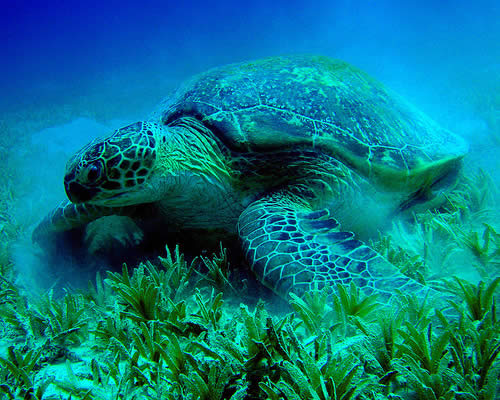
.
‘Queensland to outlaw Dugong-hunt cruelty’
.
Animal activists have welcomed moves by the Queensland Government to outlaw hunting-related cruelty to dugongs and turtles.
.
‘Under the Native Title Act, traditional owners are allowed to hunt Turtles and Dugongs.’
.
Footage aired on the ABC in March showed animals being butchered alive by some Indigenous hunters and sparked an investigation into the practice.
Queensland Fisheries Minister John McVeigh yesterday introduced legislation into Parliament to outlaw any unreasonable pain being inflicted during hunting.
The RSPCA’s Michael Beatty says the Government should be commended.
“No-one thinks – including the Indigenous leaders – that this type of cruelty, if you like, is necessary,” he said.
Mr Beatty says authorities need to continue to work with traditional owners. “It isn’t simply a case of just outlawing it, it really isn’t that simple because obviously it has to be policed as well,” he said.
But animal activist Colin Riddell says the hunting should be banned altogether. “People flock to Australia to see our Great Barrier Reef and see those beautiful animals and I fear for the day that my children, your children don’t get to see those animals,” he said.
Native title hunting rights would not be extinguished by the Bill.’
[Source: ‘Queensland to outlaw dugong-hunt cruelty’, 20120620, ABC, ^http://www.abc.net.au/news/2012-06-20/animal-rights-groups-welcome-cruelty-hunting-ban/4080688].
But this heinous cruelty by Indigenous Australians has long been know by the Australian Government..
.
Back in 2011: ‘Call for inquiry into marine animal poaching‘
.
The Federal Opposition has called for a judicial inquiry into Dugong and Turtle poaching in far north Queensland. Tourism operators say tourists have been exposed to mutilated and slaughtered turtles on island beaches, off Cairns. Four far north Queensland Liberal National Party (LNP) candidates say they want that stopped at key tourism sites.
Pictures of a mutilated turtle found on Green Island by tourists at the weekend have prompted public outrage. The animals are legally protected but the Native Title Act allows for hunting by traditional owners.
But Federal Opposition environment spokesman Greg Hunt says legal hunting is not the problem.
“The advice we have from Indigenous leaders is that the vast bulk of hunting is poaching,” he said. Mr Hunt says inaction on poaching is causing problems.
“There really has to be a crackdown on poaching,” he said. “The vast bulk of the take of Turtle and Dugong is coming from poaching. “There is a trade in illegally obtained meat and animal product. “This is a complete breach of the law.”
The Great Barrier Reef Marine Park Authority is investigating the issue.
[Source: ‘Call for inquiry into marine animal poaching‘, by Brad Ryan, ABC, 20111107, ^http://www.abc.net.au/news/2011-11-11/call-for-inquiry-into-marine-animal-poaching/3660324].
Back in 2010: ‘Cairns Turtle and Dugong activist campaigns against slaughter caught on video’
.
Former union activist turned environmental defender Colin Ridell, who counts Bob Irwin, John Mackenzie, Derryn Hinch and Greg Hunt MP among his loyal following, says the silence is deafening from the government to stop slaughter of turtles on the waters around Cairns.
Riddell is campaigning to reduce the taking of turtle and dugong, that is occurring under the protection of Native Title, until a complete scientific study is done to determine the actual numbers to be taken.
“It will be tightly controlled by the EPA and the elders with a permit system, that is monitored by special investigators. I and other indigenous elders support a moratorium to determine the take,” Riddell says. “The skulls of each to be kept to determine actual permitted numbers taken, as is done in other permit systems.”
He says that any breach would carry a substantial penalty, however advocates a complete ban in green zones, like all our coastal tourist areas. “I don’t want international tourists and interstate visitors to take home horror stories.”
The campaign follows the leaking of a graphic video showing a turtle having its flippers hacked off while still alive. RSPCA Queensland has called for a review of traditional hunting.
“It’s just not good enough, this is a violent and obscene way to treat these animals, ” Cairns resident Colin Riddell told CairnsBlog. “Any indigenous person is allowed to kill sea turtles and dugongs for weddings or funerals, but it has far beyond that, and is being commercially moved around the state.
“I don’t want international tourists and interstate visitors to take back horror stories home,” he says Riddell, who has taken his campaign to every State and Federal Government minister.
“I’ve written to the Minister for Local Government and Aboriginal and Torres Strait Islander Partnerships who have acknowledged my letter,” Riddell says. “The replied thanking me for me letter and said it ‘will be actioned as appropriate.’ However I have received no response,” he says.
Riddell has also wrote to Greg Combet for support, who he engaged with as a Manufacturing Workers Union site convener at the Australian Defence Industries Benalla plant. He says that Environment Minister Peter Garrett has also given him the “bum’s rush.”
“I received a response from the ‘Parliamentary Clearance Officer’ however it was totally unsatisfactory,” Riddell said. “I told them to get my message Peter Garrett, which was a direct result of Jim Turnour’s and Peter Garrett staffers. Weak efforts.”
Another response from the International Whaling Commission fell on deaf ears. “I asked them why we condemn Japan when Australians do the same,” Colin Riddell said. Julie Creek, responded. “Your message was deleted without being read.”
The original poster of the graphic video says that it’s fair enough if you have to kill turtles because it is a “traditional right” but who cuts the leg of a cow first and let it die in its own blood?
“No one is going to starve in Australia because we stop the killing of turtles. Australia earns millions of dollars with the tourism industry – with tourists who come to dive with turtles and in the same country we torture the turtles to death,” the anonymous poster wrote. “Species will vanish forever and in the end it does not matter whose fault it was. This is not a question of human races this is a question of respect and ethics towards other creatures.”
Colin Riddell and the RSPCA are trying to track down who shot the video and where it was taken, so they can investigate the incident. It is believed it was filmed in North Queensland mid last year.
.
“Until now cruelty to animals using traditional hunting methods has been put in the too hard basket by governments.”
.
Mark Townend of the RSPCA said. “Far from it, he said. We have Aboriginal and Torres Strait Island elders who support us on this issue.
.
“Hunting from tinnies with rifles is not traditional.”
.
“We’re committed to ensuring that any breaches of the Animal Care and Protection Act are fully investigated while at the same time taking into consideration traditional hunting rights,” RSPCA chief inspector Michael Pecic says. “We can’t do this alone. We’re a charity and yet it appears we’re the only organisation that is taking this matter seriously.”
“We have Aboriginal and Torres Strait Island elders who support us on this issue,” Riddell says. “Hunting from tinnies with rifles is not traditional. Leaving turtles and dugongs to be butchered alive and left to die on the beach is not traditional. We’re not attacking the indigenous community. This is simply not an appropriate way to kill these animals.”
James Epong, son of an aboriginal elder says that Ma:mu traditional owners have a right to hunt for protected species such as dugong and marine turtles that is recognised by Australian Law.
“Our Ma:mu traditional owners, who are also called the Mandubarra mob, have put aside some of these rights and signed a Traditional Use Marine Resource Agreement so they can protect rather that exploit dugong and marine turtles,” James Epong says.
The agreement for their turtle business is co-ordinated through the Mandubarra Land and Sea Corporation and was finalised in June 2008.
“I am very proud to see that Ma:mu traditional owners are prepared to sacrifice rights and traditions, for the sake of helping threatened turtle and dugong stocks recover,” Epong says. “Keep in mind the Ma:mu people are setting aside hunting and cultural practices that go back tens of thousands of years for the future benefit of all Australians.”
In 1996, a landmark High Court decision concerned with particular pastoral titles, was passed regarding Native Title hunting rights. The decision did not allow anyone simply to claim Indigenous links and then hunt and kill native animals anywhere in Queensland. It authorised any legitimate native title holder to hunt and kill for genuine sustenance and other needs and without first obtaining a licence, but only in areas over which native title is held by that group.
The decision did not allow native title owners to trap or kill wildlife for commercial purposes, however Colin Riddell says that this is occurring. “These area being transported through the Cairns Airport in Eskys,” he says.
Riddell says on his website that the 1996 decision says nothing one way or the other about using modern weapons like guns and powered boats to undertake traditional hunting. It is interesting that the use of harpoons, outboard-powered boats, and steel axes to kill the crocodiles as an exercise of native title hunting rights.
“It seemed to concern nobody on the High Court bench, with the possible exception of Justice Callinan. Followers of native title developments need to keep in mind the distinction between exercising an established native right in a modern way, as in the Yanner case, and the loss or abandonment of traditional and established native title rights themselves, as found by the trial judge to be a fatal flaw in the Yorta Yorta decision.”
.
Commercial Exploitation of Hunting and Fishing Rights
This issue, namely the extent to which the holders of native title may exercise the relevant rights in a “modern” fashion, and indeed the connected issue of whether they might even commercially exploit those rights, are difficult ones. Whilst not directly in issue in the Yanner case, these issues are of considerable importance in the broader scheme of Australian native title law – and are yet to be answered conclusively.
Some important developments in this area are taking place in Canada. In the Supreme Court of Canada’s 1997 decision in Delgamuukw v British Columbia, the majority judges noted that, while the rights of Indigenous title holders in that jurisdiction are not limited to engagement in activities which are aspects of practices, customs, and traditions integral to the claimant group’s distinctive Indigenous culture, lands held by Aboriginal title cannot be used in a manner that is irreconcilable with the nature of the claimants’ attachment to those lands.
So, for example, tribal hunting areas may not be “strip mined” or, so it would seem, “hunted out” or “fished out” in a large-scale commercial operation. Contrast this with small-scale trading between local Indigenous people and others, for which there is some historical and anthropological evidence in Australia and elsewhere.
There are important legal differences between the doctrines of Aboriginal title in Canada and Australia, but there are also some important similarities which indicate that these Canadian developments might in the future be of relevance in Australia. Of course, it is also important in Australia to note that the Commonwealth Native Title Act moderates but does not destroy the capacity of the States and Territories to regulate the exercise of native title rights along with other rights, as in fishing, conservation, and safety legislation which might apply equally to Indigenous and non-Indigenous people alike.
“Jim Turnour says this is a racial issue,” Colin Riddell says. “You know, I’m disgruntled as well. You know what I do. I tell you what, I’m begging people to vote for Warren Entsch in and get rid of Jimmy,” he says.
See the shocking video here…
WARNING: THIS VIDEO CONTAINS DISTURBING ANIMAL CRUELTY WHICH MAY OFFEND. WE INCLUDE IT TO PORTRAY THE REALITY OF AUSTRALIA’S TREATMENT OF TURTLES AND DUGONGS IN THE NAME OF ‘TRADITIONAL HUNTING’
[Source: ‘Cairns turtle and dugong activist campaigns against slaughter caught on video’, by Michael Moore’s Cairns.blog.net, 20100410, ^http://www.cairnsblog.net/2010/04/cairns-turtle-and-dugong-activist.html].
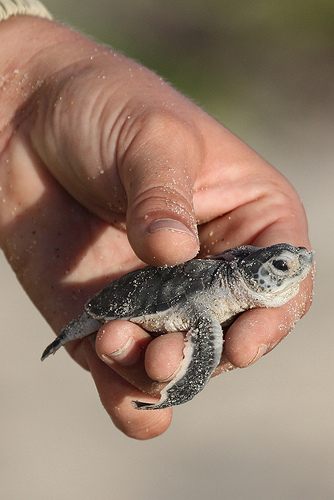 A species completely at our mercy
A species completely at our mercy
.
Ed:
- The Great Barrier Reef Marine Park Authority has been aware, so is complicit, immoral, incompetent and so entire Board should now be immediately sacked, and any government employee (rangers or otherwise found to have been in anyway involved with the killing of Dungongs or Turtles or trading in their body parts.
- The killing of Dungongs or Turtles in Australia is to be immediately policed and investigated jointly by the Australian Government, whatever the causes of the deaths
- The Australian Government needs to amend Australia’s Native Title Act 1993 and Australian Crimes Act 1914 to make any cruelty toward any wildlife in Australia and its territories a criminal act under Australian Crimes Act. Traditional Hunting that involves cruelty is to be outlawed. It is Commercial Exploitation of Traditional Hunting and Fishing Rights.
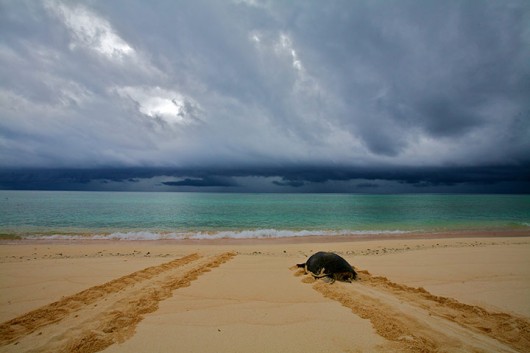 An horrific life, a bleak future
An horrific life, a bleak future
.
References and Further Reading
.
[1] The Great Barrier Reef inscription on the UNESCO’s World Heritage List, ^http://whc.unesco.org/en/list/154.
[2] Australian Goverenment ^http://www.environment.gov.au/heritage/places/world/great-barrier-reef/values.html.
[3] Great Barrier Reef ^http://www.greatbarrierreef.org/great-barrier-reef-facts.php.
[4] The Great Barrier Reef Marine Park Authority ^http://www.gbrmpa.gov.au/.
[5] ‘Three kilometres of Great Barrier Reef damage, 20 years to mend‘, by Tom Arup, The Age newspaper, 20100414, ^http://www.theage.com.au/environment/three-kilometres-of-great-barrier-reef-damage-20-years-to-mend-20100413-s7p8.html“It could take 20 years or more for the Great Barrier Reef to recover from three kilometres of destruction caused by the grounding of a Chinese coal ship, authorities have revealed. The Great Barrier Reef Marine Park Authority says the damage to the reef is significant, with large parts of Douglas Shoal “completely flattened” and marine life “pulverised”.
.
[6] ‘WWF Welcomes investigation into marine wildlife deaths‘, World Wildlife Fund, 2011, ^http://awsassets.wwf.org.au/downloads/pr252_wwf_welcomes_investigation_into_marine_wildlife_deaths_17jun11.pdf [>Read Media Release] – that was last year..
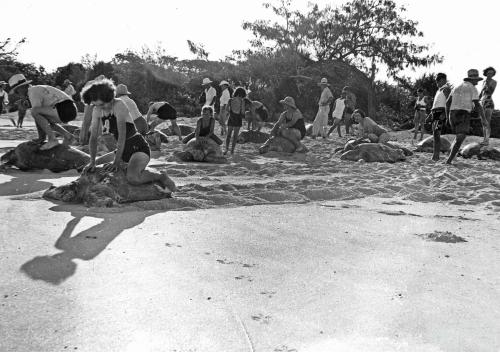 Australians Turtle Riding on Heron Island
Great Barrier Reef, 1938
[Source: © Queensland historical Atlas, ^http://www.qhatlas.com.au/category/keywords/great-barrier-reef]
Australians Turtle Riding on Heron Island
Great Barrier Reef, 1938
[Source: © Queensland historical Atlas, ^http://www.qhatlas.com.au/category/keywords/great-barrier-reef]
.
Tags: Aboriginal Poaching, animal cruelty, animal welfare, Australia, Cape York, Cape York Peninsula, cites, Delgamuukw v British Columbia, Dugong, Gladstone Harbour, Great Barrier Reef, Great Barrier Reef Marine Park, Great Barrier Reef Marine Park Act 1975, Great Barrier Reef Tourism, Green Island, Green Sea Turtle, hacking holidays, Indigenous Culture, iucn, Lady Elliot Island, Queensland Holidays, Scientific Advisory Committee, Sea Grass Meadows, Shen Neng I, The Great Barrier Reef Marine Park Authority, Traditional Hunting Perversion, UNESCO's World Heritage Committee
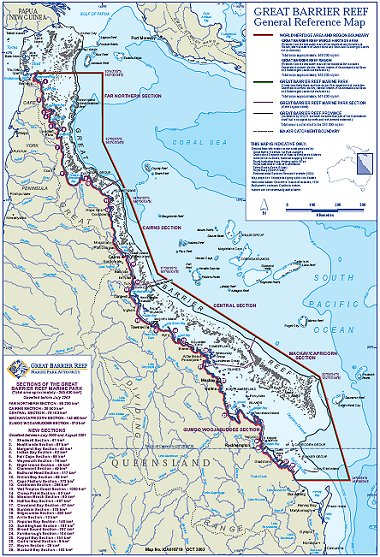

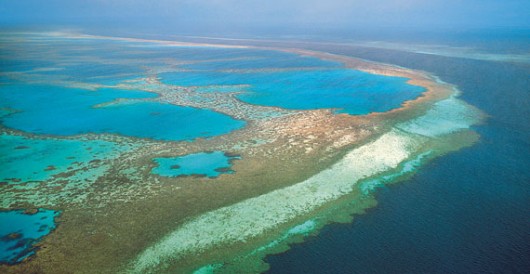

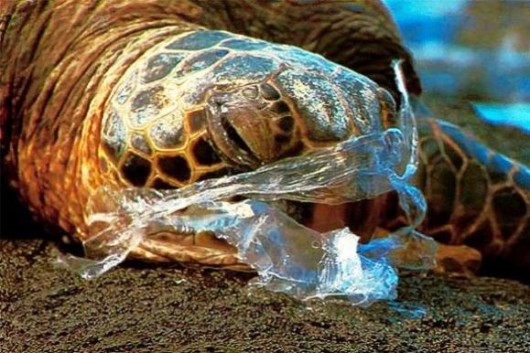
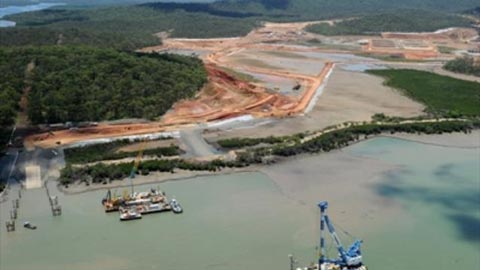
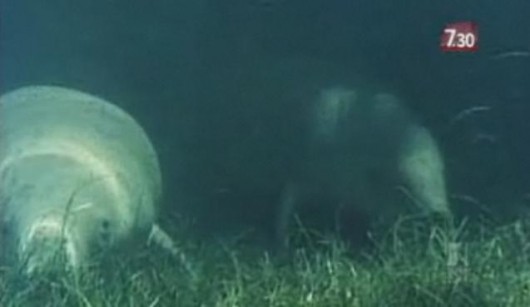

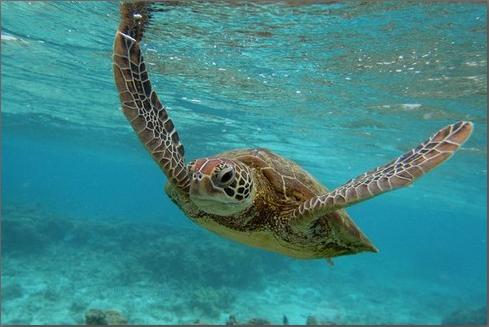
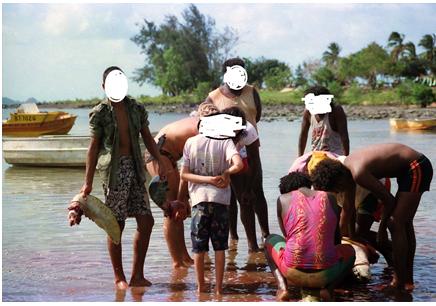











This is absolutely disgusting, beyond belief..The government in Australia has alot to answer for..They are beyond useless..